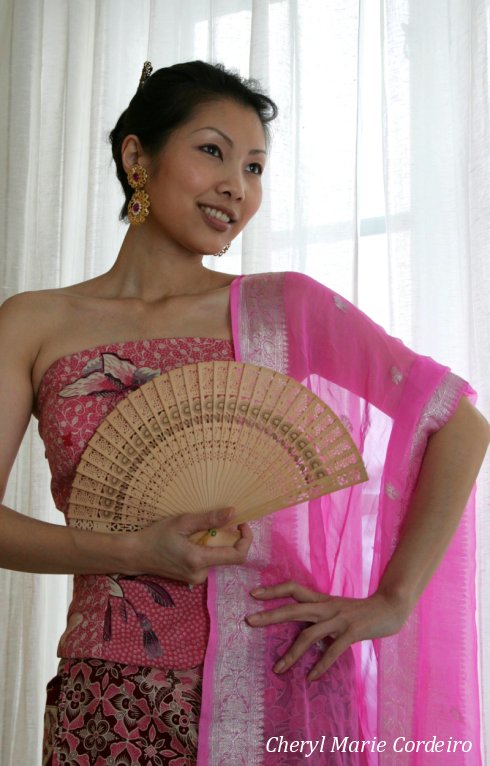
In various shades of pinks – traditional silk dyed batik and batik sarong with a sari shawl. Outfit is by Francis Louis Ler of Amor Meus, Purvis Street, Singapore.
Photo © JE Nilsson and C M Cordeiro-Nilsson for CMC 2010
Colours of the cultures of Asia never fail to bring a smile on my face and put me in a festive mood, from the colourful saris of India, to the brightly hand painted silks of the Chinese qipao and the intricately patterned, waxed drawn batiks of Indonesia and Malaysia. Even the colours and texture of raw silk from Thailand draw my attention when I see them.
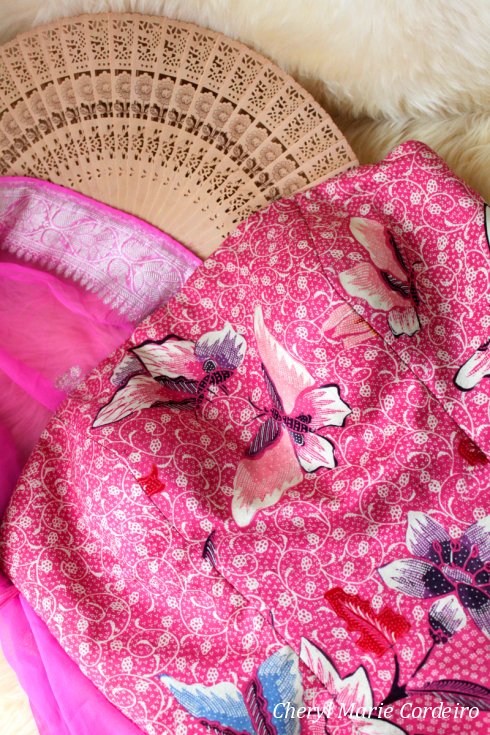
Brighter than the traditional batiks.
Influenced by Hinduism, traditional colours for batik prints, especially those found in Java Indonesia include dark blues or indigos, earthern tones such as dark brown, and white. These colours represent the three major Hindu Gods – Brahmā, Visnu, and Śiva.
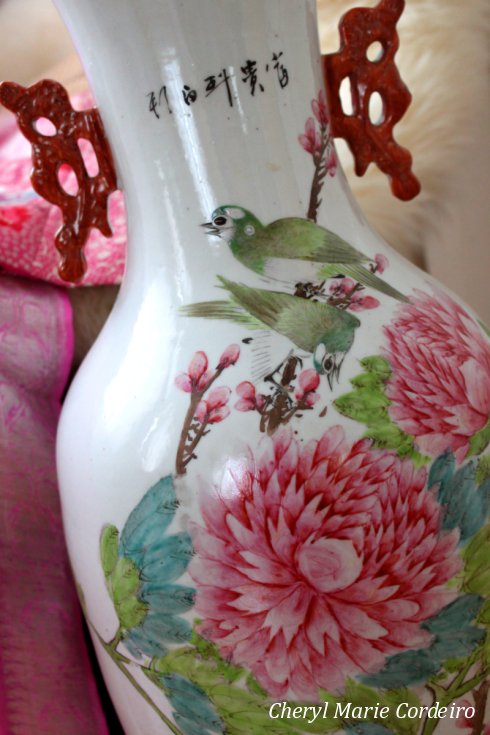
The traditional colors of Southeast-Asia are reflected even in its decorative porcelains. Qing dynasty vase with the same pink shades we find in the traditional fabrics of today. Vase dated 1899 and hand painted with birds and large peonies in a style introduced by the late Empress Dowager Cixi, of China.
I’ve been asked several times about my traditional ethnic dress. And having grown up in Singapore, I have found it difficult to articulate any appropriate answer since I would consider the qipao and the sarong keyaba as much my own traditional folk dress as the Basque influenced traditional Portuguese dress. I would also have no qualms wearing a sari should the event allow for it.
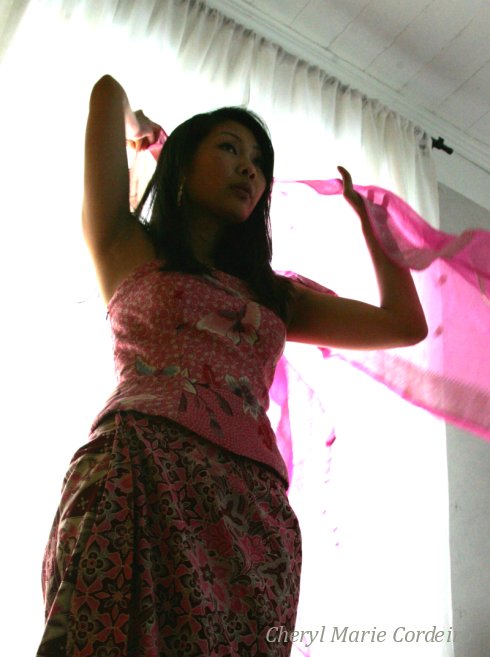
Traditional sarongs are wrapped and tied around the waist. This more modern one is sewn and fastened with buttons. The batik fabric has different patterns that are reversible, on both sides of the fabric.
The unique outfit that was given to me by my mother, is a variation of the Nonya sarong kebaya, a bolder version as it were, since a traditional kebaya would call for a sheer long sleeved top that covered the shoulders and the length of the arms. The bustier top is silk batik that is hand drawn and dyed while the bottom part is a wraparound batik sarong skirt.
Globalization in textiles
While the word batik stems from Java and refers to a specific method of piercing fabric with the use of a needle or sharp tool filled with with wax, and thereafter dyeing the fabric in various colours to created a pattern, the method is ancient and dates at least as far back as 4th century BC Egypt. In Asia we find this method of decorating fabric in the open and multicultural Xia’n, capital of Tang Dynasty (618-907) China.
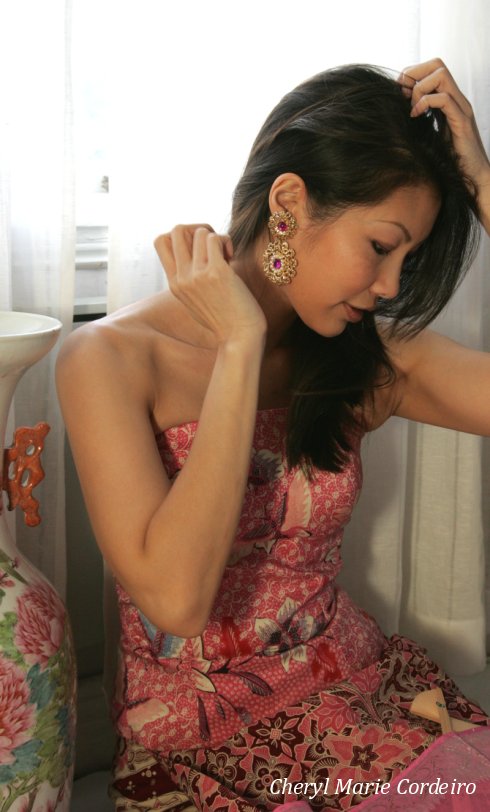
Most motifs on Asian art are traditional in that they carry a symbolic value that belong to the culture. Both the silk dyed batik top and the Chinese vase have the spring season of a colder climate as their theme.
Different from the more traditional Javanese batik prints, that are often found in more neutral or dark colours such as indigo, brown and white, the batik fabrics in this outfit are in varying shades of red, pink and purple that call to mind the colours of Holi and the saris of India.
A one of a kind design by Francis Louis Ler
This outfit was created by Francis Louis Ler of Amor Meus in Singapore, a result of his love of colour. Being a long time friend, I never fail to visit his shop at Purvis Street when back in Singapore. Entering his shop is like entering a dream of a fabric factory with the pulse, colours and patterns of Southeast-Asia. His pieces are usually singular in design, some of which I feel would rather belong in a museum collection. Specializing in bridal wear and traditional Southeast-Asian costumes, such as the kebaya and cheongsam or qipao, Louis scours the region for unique fabrics that pique his fancy and inspire him to his next creations.
When it comes to brighter colours entering Southeast-Asian art I believe we can trace it back to at least the early Qing Dynasty, when the Rococo period of France, created a flair for pastel colours throughout the world, one that came to stay as the pastel colours of the famille rose decorations of porcelain and eventually the Straits Chinese porcelain of the Malacca peninsula.
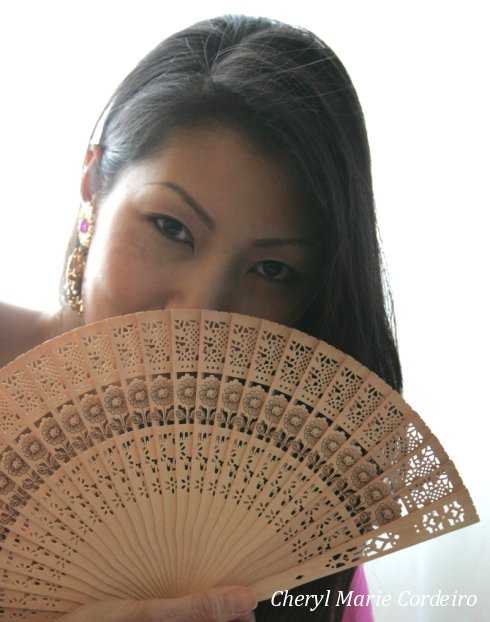
I was very happy to have found these pieces together with my mother, since behind each handicraft is a story. To me the many aspects of history and international influences, further interpreted in the Southeast-Asian context make me feel that I am not only wearing a dress but am living a part of history, one that is traditional and one that is still in the making.
This outfit being in many shades of red, I look forward to wearing this during the upcoming Chinese New Year, where red is the symbolic colour of luck, happiness and prosperity.